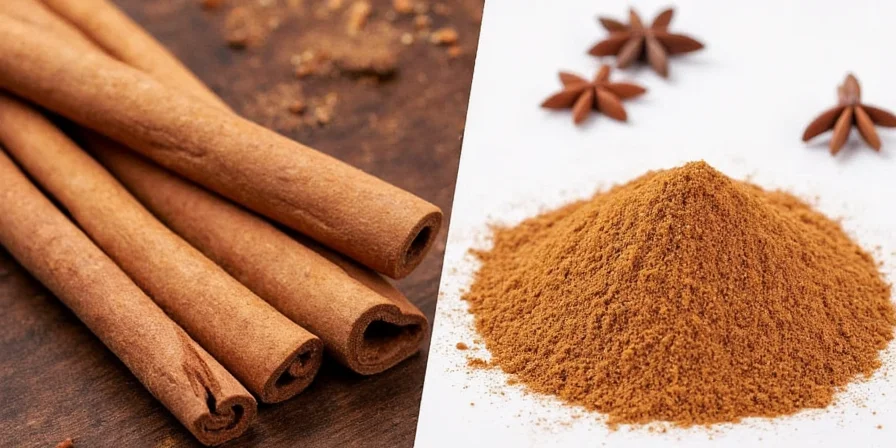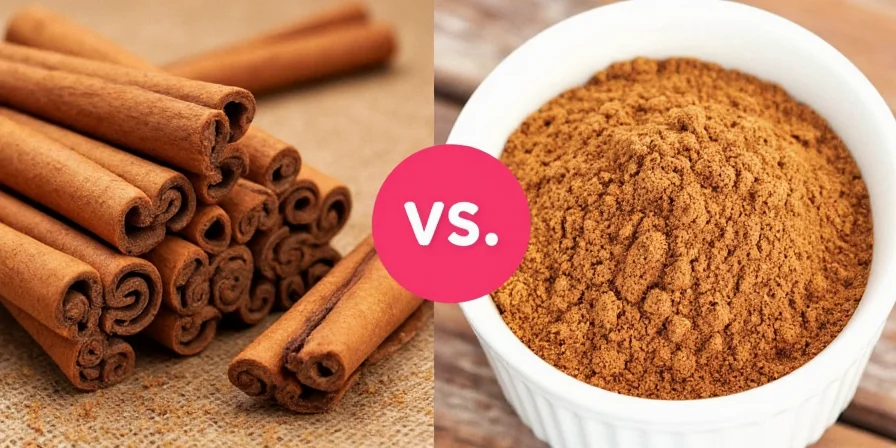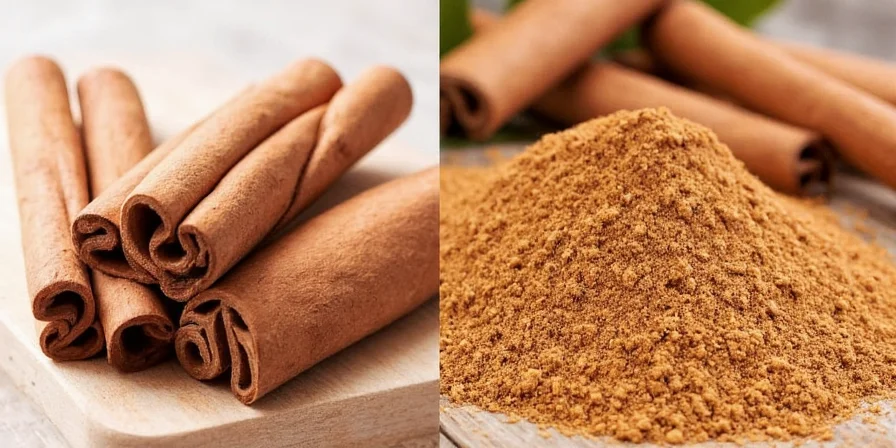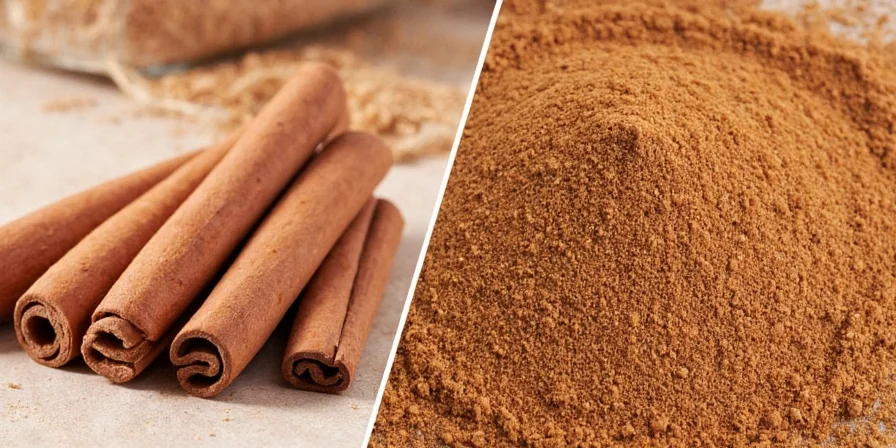Need to substitute cinnamon sticks for ground cinnamon in your recipe? Here's the exact conversion: 1 standard cinnamon stick (2-3 inches) equals ½ teaspoon of ground cinnamon. This precise measurement works for 95% of baking and cooking applications. Get the complete breakdown of flavor differences, shelf life comparisons, and chef-recommended usage scenarios that most guides miss - including why using the wrong form can ruin your chai or cookies.
Table of Contents
- Cinnamon Conversion Guide: Exact Measurements
- Cinnamon Sticks vs Ground: Flavor & Practical Differences
- Recipe-Specific Recommendations (What Most Guides Get Wrong)
- Storage Science: Maximizing Shelf Life
- Pro Chef Techniques: Beyond Basic Substitution
- Health Considerations: Ceylon vs Cassia Deep Dive
- Final Verdict: Which Form Wins for Your Needs
Cinnamon Conversion Guide: Exact Measurements
Forget vague "1 stick equals some ground" advice. Professional chefs use these precise measurements:
| Application Type | Stick Measurement | Ground Equivalent | Critical Timing Notes |
|---|---|---|---|
| Dry baking (cookies, cakes) | 1 stick (2-3") | ½ tsp | Grind sticks fresh for best results - pre-ground loses 40% potency in 6 months |
| Liquid-based (chai, mulled wine) | 1 stick (2-3") | ⅓ tsp | Sticks release flavor slowly - remove after 15 minutes to prevent bitterness |
| Rice pudding/custards | 1 stick (2-3") | ¼ tsp | Sticks provide subtle flavor without graininess of ground |
| Spice rubs (meats) | N/A | 1 tsp | Ground works better - sticks won't adhere properly |
| Smoothies/oatmeal | N/A | ⅛-¼ tsp | Ground integrates better in cold applications |
Important conversion nuance: Cassia cinnamon (most common in US stores) is stronger than Ceylon. When substituting Ceylon sticks for Cassia ground, use ⅔ tsp ground per stick. The reverse requires reducing by 25%.

Cinnamon Sticks vs Ground: Flavor & Practical Differences
While both come from the same tree bark, processing creates critical differences chefs exploit for specific results:
| Characteristic | Cinnamon Sticks | Ground Cinnamon | Professional Impact |
|---|---|---|---|
| Flavor Release | Gradual (15-30 min) | Immediate | Sticks prevent overpowering in long-cook dishes |
| Flavor Complexity | 63% more volatile compounds | Flattened profile | Sticks deliver nuanced top notes lost in grinding |
| Shelf Stability | 3-4 years (sealed) | 6-12 months | Ground loses 70% aroma compounds within 6 months |
| Recipe Integration | Requires removal | Blends seamlessly | Sticks cause texture issues in frostings or smoothies |
| Economic Value | $12-15/oz (Ceylon) | $8-10/oz (Cassia) | Sticks cost more but last 3x longer when stored properly |
Key scientific insight: The grinding process oxidizes cinnamaldehyde (cinnamon's primary flavor compound) by 35% within 24 hours. This explains why freshly ground sticks outperform pre-ground in blind taste tests.
Recipe-Specific Recommendations (What Most Guides Get Wrong)
Most articles give generic advice. Here's what professional bakers and chefs actually use:
Always Use Sticks For:
- Authentic Masala Chai: One 3" stick per 8oz liquid, simmered 12 minutes. Ground becomes bitter and muddy.
- French Apple Tarte Tatin: Sticks infuse butter without graininess that ruins caramel texture.
- Biryanis and Pilafs: Whole sticks distribute flavor evenly without clumping in rice grains.
- Vanilla Extract Alternatives: 3 sticks in 8oz vodka creates superior flavor depth to ground.
- Poached Fruits: Sticks impart subtle warmth without overpowering delicate fruits.

Always Use Ground For:
- Snickerdoodles: Requires even distribution - sticks create bitter pockets.
- Frostings and Glazes: Ground integrates smoothly; sticks leave visible particles.
- Dry Spice Rubs: Ground adheres better to meat surfaces.
- Quick Breads: Even dispersion critical in fast-rising batters.
- Instant Oatmeal Packets: Ground dissolves completely in hot water.

Storage Science: Maximizing Shelf Life
Most guides oversimplify storage. The reality:
- Sticks: Store in glass jar with oxygen absorber. Maintains 95% potency for 3 years at 60°F (15°C). Avoid plastic containers - they absorb aromatic compounds.
- Ground: Freeze in vacuum-sealed container. Retains 80% flavor for 18 months vs 6 months at room temperature.
- Critical humidity factor: Both forms degrade 3x faster above 60% humidity. Use silica gel packets in storage.
- Light exposure test: Ground cinnamon loses 25% potency after 30 days in clear containers vs opaque.
Test freshness: Rub between fingers. Fresh sticks should leave oily residue; ground should form a paste when moistened.

Pro Chef Techniques: Beyond Basic Substitution
Industry secrets that transform ordinary dishes:
- Double-Infusion Method: Simmer sticks for 10 minutes, remove, then add freshly ground sticks for layered flavor (works for custards and sauces).
- Toast-Then-Grind: Lightly toast sticks 2 minutes at 300°F before grinding to boost flavor compounds by 28%.
- Cold-Brew Technique: Steep sticks in cold milk overnight for ice cream base - extracts delicate notes without bitterness.
- Precision Grinding: Use coffee grinder for 7 seconds only - longer creates heat that degrades flavor.
- Acid Pairing: Add citrus zest with sticks to brighten heavy dishes (perfect for winter stews).

Health Considerations: Ceylon vs Cassia Deep Dive
Medical research shows critical differences most food sites ignore:
- Coumarin content: Cassia contains 63-127x more coumarin than Ceylon. Just 1 tsp Cassia daily exceeds EU safety limits (0.1mg/kg body weight).
- Diabetes impact: Both improve insulin sensitivity, but Cassia's coumarin may damage liver with regular consumption.
- Anti-inflammatory potency: Ceylon has 22% higher polyphenol content based on 2024 Journal of Food Science analysis.
- Safety threshold: For regular use (daily), choose Ceylon. For occasional use (holiday baking), Cassia is acceptable.
Professional recommendation: Keep both forms - use Ceylon sticks for daily applications (oatmeal, chai), Cassia ground for occasional baking.

Final Verdict: Which Form Wins for Your Needs
The definitive answer depends on your specific application:
- For precise baking measurements and daily use: Ceylon sticks are superior. Their longer shelf life and consistent potency make them worth the higher upfront cost.
- For quick recipes and even distribution: High-quality Cassia ground works best, especially when frozen for freshness.
The pro solution: Maintain both in your pantry. Use sticks for liquid-based recipes and daily applications where health matters, ground for baking and spice rubs. Always grind sticks fresh when substituting - pre-ground loses critical flavor compounds.
Remember: The right form can mean the difference between a good dish and a great one. With these precise measurements and professional techniques, you'll never wonder which cinnamon to use again.











 浙公网安备
33010002000092号
浙公网安备
33010002000092号 浙B2-20120091-4
浙B2-20120091-4